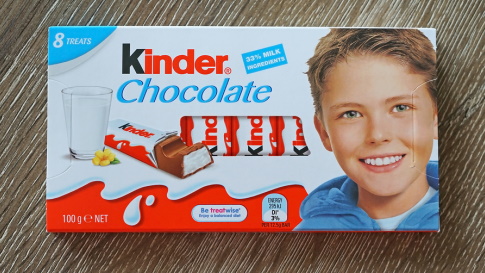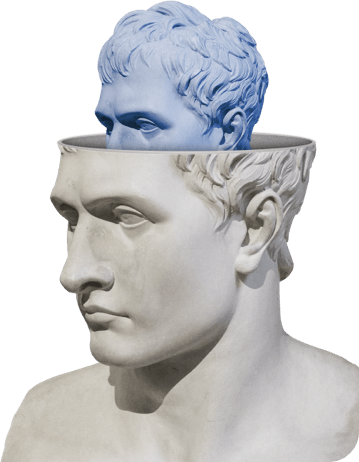How to create great packaging? Here's a marketing lesson from Kinder
-
 Jiri Boudal
Jiri Boudal
- 1. March 2022
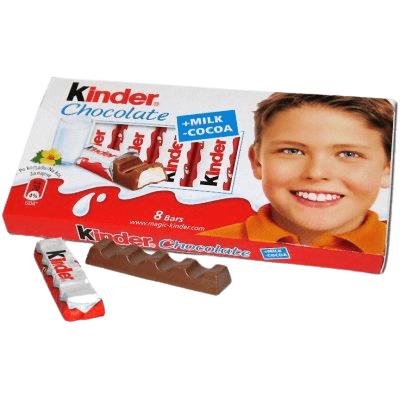
When Czechs have a sweet tooth, they don’t really think of Kinder. But they end up buying it nevertheless. How is that possible?
Mostly thanks to systematically developed visual brand assets on the packaging, which we will explore thoroughly in this case study.
Almost nobody thinks of Kinder
Salience (the quality of being particularly noticeable) is usually strongly correlated with the buyer’s behavior. This principle applies to Milka as well as Orion, which you can see on the graphs below.
Which brand do they recall when you have a sweet tooth?
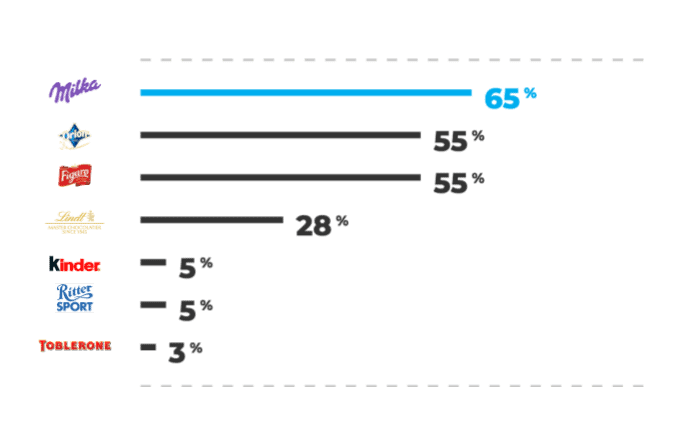
Kinder is spontaneously recalled by only 5% of potential customers. However, during the previous months it was bought by 43% of them, which is the same percentage that Orion gained with significantly better general salience.
Have they purchased any of the following during the past half year?
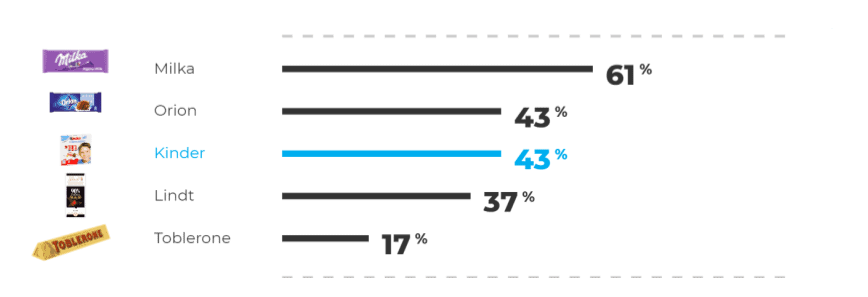
Kinder is the exception that proves the rule
So, the metric of general brand salience is usually strongly correlated with clientship. But in the case of Kinder, this does not apply. The amount of chocolate sold does not correspond to the relatively low level of brand salience, as you can see clearly on the graph. We will explore the reasons why.

What is the secret of success?
For customers to choose a specific product, they first need to spontaneously think about it in the shopping situation. According to Harvard professor Geralt Zaltman, 95% of purchasing decisions are subconscious.
Because of this, when marketing a product to a consumer, it is most effective to target the subconscious mind.
But how to best appeal to the subconscious? It would be a mistake to communicate in rational language, use arguments, or state calculations or benefits of the product. The subconscious is indifferent to those. It operates in the sphere of memories, emotions, and associations, and is trained to connect these quickly and almost effortlessly.
The so-called brand assets (or distinctive assets) help navigate this process. A brand asset is a sensory trigger. It can be visual, auditory, a smell or even a touch. The most typical examples of brand assets are logos, slogans or mascots.
But the variety is almost endless, and can even include rituals such as when baristas at Starbucks write the names of customers on the coffee cups.

How do brand assets work?
Based on current knowledge of behavioral science and our own research, we distilled three key dimensions of brand assets:
- They are well known. They are recognizable. People can easily distinguish them even from afar and connect them with a brand.
- They are unique. Brand assets are connected to one brand only and cannot be confused with another.
- They reflect people’s needs. Brand assets symbolise what potential customers want.
Now we will investigate how the three conditions are met in the case of Kinder.
Brand assets make Kinder stand out
Customer decisions can be turned around at the last minute by a number of factors such as seasonal sales, position of the goods on the shelf, or design of the packaging. Part of our decision-making process is literally happening in the aisle. And that is an opportunity for brand assets to shine.
Let’s dismantle Kinder packaging design and analyze it piece by piece first.
You can see in the graph that the child on the cover, the milk drop on the red background, and the shape of the chocolates are all very strong brand assets.
Thanks to the graphic features mentioned, the whole package is easy to identify for 94% of non-clients and 96% of clients. So, the first dimension of good brand assets – that they are well known – is satisfied.
How many people can connect a brand asset with Kinder?

The brand team is cleverly repeating the graphic features throughout the range of products and making them even more noticeable as a group because of that. This strategy also increases the likelihood that new lines and limited editions of Kinder will be noticed in the store and thought of as a desirable candy purchase .
Another nice touch is repeating the word Kinder on every single product. There is Kinder Bueno, Kinder Surprise, Kinder Happy Hippo, Kinder Duplo and so on. The brand is always present, always an inseparable part of the product.
Just look at the picture below – it shows a very systematic approach towards the brand at first sight.

We have already established that Kinder packaging designs are well known and easily distinguishable.
They are well-liked as well – 87% of Czechs evaluate the packaging positively. Aesthetic feeling is of course highly subjective but there is one behavioral principle contributing to a general preference for something – the human brain is set on lowering glucose consumption and because of that it tends to prefer easy-to-figure-out things over complicated ones.
Repeating the visual brand assets of Kinder on every single product together with the name of the brand makes it simple for the brain to process. And as a result we like it better.

The packaging effectively communicates: I’m a good choice for the kids
Kinder literally means children in German. And the brand perfectly fulfills the need to buy some sweet treats for the kids. When we walk in the store with just a vague idea of what we are getting, Kinder products draw our attention and, thanks to all the advertisements we have been exposed to earlier, the idea “Oh, this is just perfect for the kids” suddenly appears. According to our research, this is the case for 68 % of Czechs.
How to repeat the success of Kinder with your brand?
Well-designed packaging is the final part of a campaign, the last chance to attract a buyer.
The excellent work with the subconscious mind that Kinder performs can be repeated by your brand as well. Customers can reach for your product almost automatically if you know how to engage their subconscious.
Whatever your situation – running an established brand or beginning something brand new – it is never too late to start testing.
Or you can conduct the most expensive experiment of all – invest in your brand blindly without data.
About the research
- Quantitative research, CAWI
- Data collected January 19–20, 2021
- Sample size of 500 respondents, representative of the Czech online population.

